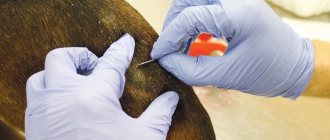In terms of the number of infections among cats, the subcutaneous mite or demodex mite is second only to fleas. It causes a disease called demodicosis, which in turn comes in two types: localized and generalized. The first type involves infection of one area on the body (for example, ears, eyes, withers, etc.), while with the second type, several areas of the skin are affected.
If even minor symptoms of demodicosis are detected, you should immediately seek help from a veterinarian.
Types of diseases caused by subcutaneous mites
- Actually demodicosis. Develops due to inflammation, which is provoked by waste products of microorganisms. Manifests itself in the form of external damage to the skin and hair.
- Ear scabies is the most common type of demodicosis. Formed when the parasite enters the ear or lymph nodes in this area. It contains many nutrients for mites: skin tissue, earwax, dandruff and other formations. If an animal is affected by a disease, then black dirt appears in the ears, which is the waste products of microorganisms and congealed blood. The main sign of pathology is an unpleasant putrid odor.
Risk group
Almost any animal can become infected with demodicosis. Even home maintenance and proper care do not guarantee complete safety. And under certain circumstances, the risk of infection increases.
Cats that do not receive appropriate care are more susceptible to mite infestation. Unsanitary conditions favor the proliferation of parasites. Animals with a weakened immune system, elderly cats with reduced protective function of the skin, as well as with incompletely treated chronic pathologies are more susceptible to demodicosis, and the disease itself in this case is characterized by a rapid course.
Caring for a sick pet
Pets with demodicosis require special care. The success of recovery largely depends on this. During treatment and the rehabilitation period, a number of rules must be followed:
- Provide the animal with peace and care. It is recommended to place the cat in a separate room where it will not be disturbed. You can't leave her alone for a long time. A sick pet requires participation and maximum tenderness.
- Create a favorable environment in the house. An animal, exhausted by painful injections and medications, needs peace and a positive attitude. The success of recovery largely depends on his emotional state.
- Follow a diet. To strengthen a weakened body, which has devoted all its strength to fighting the disease, a light but high-calorie diet is required.
- Strictly follow all veterinarian's instructions.
- Take your pet to a veterinarian regularly to assess its condition.
- At the slightest suspicion of deterioration in your pet's condition, immediately show it to a doctor.
Causes and routes of infection
Demodectic mange in pets can develop under the influence of the following sources:
- worms and intoxication caused by waste products of these parasites;
- weakened immune system;
- improper and unbalanced diet;
- lack of vitamins A, E and B;
- keeping your pet in damp, dirty conditions.
Demodectic mange can be transmitted through contact between a cat and another infected animal or from the mother to a kitten. In some situations, the baby may be infected during intrauterine development. The length of the incubation period depends on the state of the animal's immune system.
Symptoms of demodicosis
Localization of demodex is most often noted in the abdomen, withers, ears, muzzle and tail. The parasite can multiply and live on a cat for quite a long time, while the disease itself will not manifest itself. When an animal's immunity decreases, the following symptoms are observed:
- deterioration in the appearance of fur;
- the appearance of peeling in the eye area;
- damage to skin pigmentation;
- detection of dandruff throughout the fur;
- hair loss in some areas;
- acne formation;
- due to itching and discomfort, the pet itches all the time, scratching the damaged skin until it bleeds;
- a hardened crust up to 2–12 mm high forms in the infected area;
- ichor is released on the growth;
- bald areas become covered with small ulcers and acquire a pearlescent hue.
Such symptoms appear due to the constant movement of the parasite across the skin, which leaves its waste products on it. To see demodex, the balding areas need to be gathered into a fold. The found parasite and the pet itself should be immediately taken to a veterinary hospital for diagnosis and appropriate therapy.
Also read the article about eye diseases in cats so as not to confuse their symptoms with demodicosis.
Pathogens
Demodicosis in cats is caused by 2 types of microscopic mites: Demodex cati and Demodex gatoi . The first lives in hair follicles and adjacent tissues, the second - in the superficial layers of the skin. The size of the parasites does not exceed 0.5 mm; they can only be seen under microscope magnification. The transparent body is supported on legs with hooks, the oral cavity looks like a proboscis.
Demodex develops in the body of one carrier and dies in the external environment after 2 hours. An adult gnaws through the epidermis, penetrates the hair follicle, where it feeds on cell breakdown products, sebum and reproduces.
From the egg to the mature individual, the tick passes through the stages of larva, protonymph and deutonymph. The parasite develops in both active and passive forms: in the first it feeds and grows, in the second it becomes motionless. The biological cycle lasts 20–25 days; in 3 months, at least 3 generations of mites develop in the cat’s body.
More often, demodicosis affects animals under 2 years old, elderly and emaciated.
Siamese and Burmese cats are more susceptible than other breeds.
Mr. Cat warns: is Demodex harmful to humans?
Although humans are also susceptible to demodicosis, the parasite that infects pets is completely harmless to us. The fact is that the disease develops in people when infected with another species of this tick. However, you should be careful, if there are other animals living in the house, then the sick cat must be isolated, as it can easily infect them. And also monitor the other inhabitants of the apartment to detect the disease in the initial stages.
Diagnostics
When making a diagnosis, it is important not to confuse this disease with similar diseases in cats, such as ringworm or dermatitis. Therefore, the veterinarian pays attention not only to external symptoms, but also conducts diagnostics in the laboratory.
To do this, you need to take a sample of the affected skin and carefully examine it. In severe cases, scraping reveals the presence of parasites that are at different stages of development, namely eggs, larvae and mites. If only adult individuals are found during scraping analysis, then the carrier is considered safe for other animals. In addition to obtaining a scraping, they may take a swab sample from the ear, which is examined using a microscope.
Treatment of demodicosis in cats is prescribed by a doctor after an external examination and study of test results. It happens that in order to detect a tick it is necessary to take scrapings several times from different parts of the animal’s body. If your cat licks itself thoroughly, you can find ticks in its feces, which will help with diagnosis. Provided that the cat does not have external symptoms of demodicosis, it is also advisable to undergo tests to exclude the presence of a tick.
Methods for treating demodicosis in cats
Removing demodex from cats is quite difficult. Initially, it is recommended to bathe your pet with Doctor or Elite shampoos. The purpose of the procedure is to cleanse the skin of suppuration, dandruff and lymph. Afterwards, you need to disinfect the damaged areas with Chlorhexidine or hydrogen peroxide. And when the skin dries, proceed to the main treatment: the use of external medications - for mild cases of the disease - or injections - for severe cases.
In the absence of help for the pet, the parasite begins to lay larvae. Particularly serious cases can lead to the death of the cat.
Medicines and injections
When an animal is initially infected, it is quite difficult to decide on the choice of drugs to eliminate parasites. Each type of disease requires its own medications to treat, so it is best to seek help from a veterinarian.
Localized demodicosis
In this case, damage to small areas of the skin is observed. Only a veterinarian selects the drug and can prescribe ointments, shampoos and sprays. Basically, the doctor prescribes the following medications:
- Sulfur or aversectin ointments;
- Unoiled;
- Tsidem;
- Liniment Demos;
- Amit;
- Ivermek-gel.
Do not forget that the products are applied to skin cleansed of hair.
The pet also needs medications to boost its immunity. Usually prescribed:
- Gamavit;
- Immunoparasite;
- Gala Vet;
- Maxidin.
Generalized demodicosis
This type of disease is more difficult to treat because all of the pet’s skin is damaged. Do not despair even if your animal develops ulcers and severe irritation - the disease can be overcome.
To better absorb the medication for external use, the cat should be trimmed and bathed with a special shampoo (Doctor VIC). Then the skin is soaked in sea buckthorn oil, and after it dries, the prescribed medication is treated.
If the disease is severe, injection solutions are prescribed:
- Cydectin – single dose – 0.4 ml;
- Dectomax - the dose is determined by the veterinarian taking into account the pet’s body weight.
The development of complications indicates the addition of a secondary infection. In such a situation, a course of antibiotics is prescribed:
- Betamox;
- Amosina;
- Amoxicillin;
- Kanamycin;
- Baytrila.
It is important for an animal to eat properly. You should include foods rich in vitamins and minerals in your diet.
Let's sum it up
To summarize, it must be said that demodicosis is not such a terrible disease. It can be overcome quite easily, especially if it is noticed in time. Your task is precisely the timely detection of the disease and the subsequent delivery of your beloved four-legged friend to the veterinarian. The doctor will figure it out further: he will make an accurate diagnosis, determine the course of medications and set the next appointment date. Treatment will take a long time even if you begin to eliminate the disease on time. Remember this and don’t delay going to the doctor, because while you hesitate, your pet will suffer.
Sources
- https://gafki.ru/koshki/demodekoz.html
- https://MurKoshka.ru/zdorovye/bolezni/demodekoz-u-koshek.html
- https://pets-expert.ru/demodekoz-u-koshek-simptomy-i-lechenie/
- https://68koshek.ru/zdorove/bolezni/podkozhnyj-kleshh-demodekoz
- https://murkotiki.com/demodekoz-koshek-podkozhnyie-kleschi
- https://MrKot.com/demodekoz-u-koshek
- https://kotikiinfo.ru/podkozhnye-kleshhi-u-koshek/
- https://lechenie-koshek.ru/demodekoz-u-koshek-lechenie-v-domashnix-usloviyax-foto-priznaki/
[collapse]
ethnoscience
The use of home remedies in the treatment of demodicosis is allowed only if the veterinarian has not found any restrictions. Moreover, such methods are not suitable for a generalized form of the disease. As folk remedies for eliminating subcutaneous mites, you can:
- Every day, bathe the animal with Doctor shampoo, and then wipe the damaged skin with a decoction of chamomile and sage. To prepare the drug, you need 1 tbsp. l. Pour 0.5 liters of hot water over each plant and cook for 10 minutes. Cool the liquid and warm it up slightly each time before use.
- Bathe your pet with tar soap, and then treat the infected areas with calendula tincture.
- Wipe areas where hair has fallen out twice a day with kerosene. After treatment, do not wash the cat for 2 days.
During the treatment process, it is important to disinfect the pet’s resting place and its belongings. All medications for external use must be warmed to room temperature.
It should be borne in mind that traditional methods can provoke intoxication and other serious consequences.











